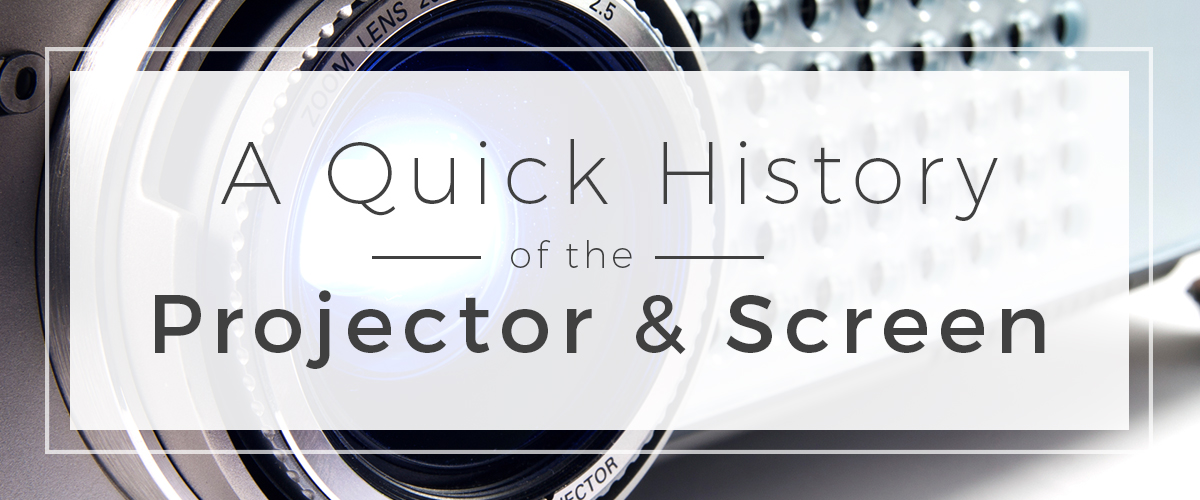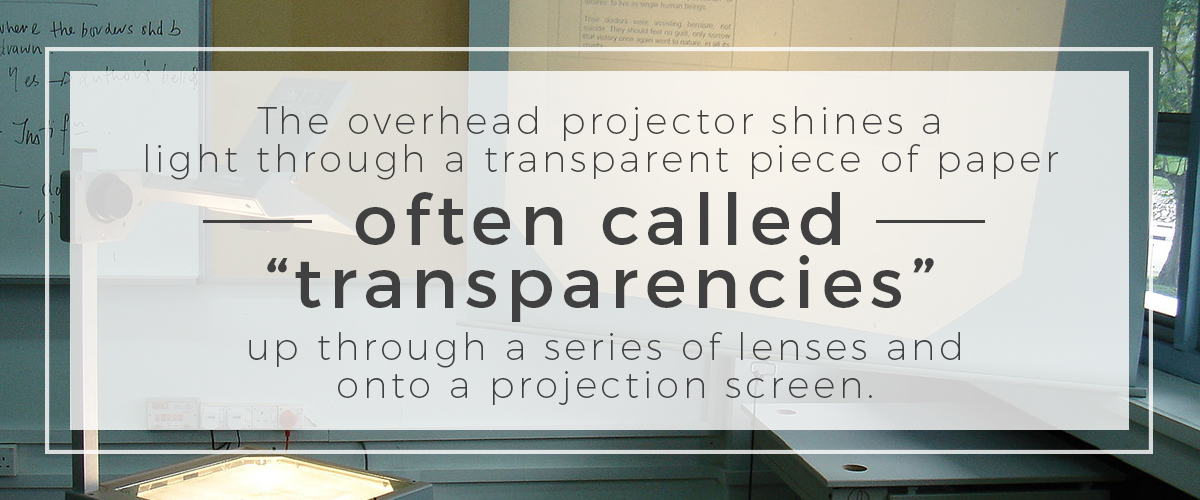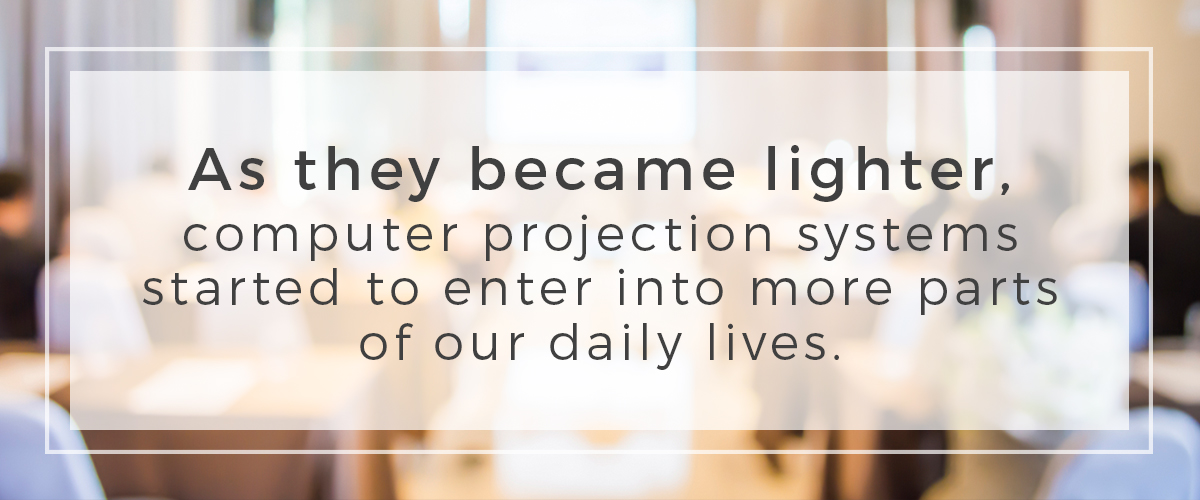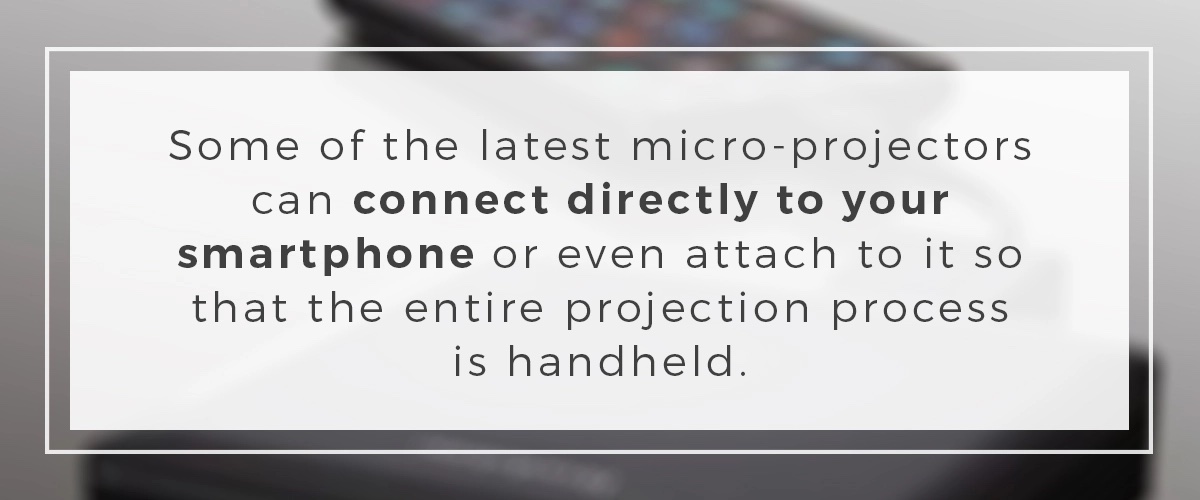
Video is everywhere in our lives, but there were long periods of human history where the only images we saw created through non-conventional means were accidents or illusions thrust onto cave walls. The history of the projector and the projection screen begins alongside ours, with a slow progression until modern times, where technology has advanced at an unprecedented pace.
Here’s a brief look at many of the amazing steps that projectors and projector screens have gone through over the years.
Pinhole Imagery
Long before we had digital projector screens, our ancestors were peering through animal hides and watching lights that danced as they entered through tiny, likely unexpected holes. Knowledge of these pinhole images are believed to be as old as humanity’s desire to create a shelter made of hide.
These would be the natural occurrence of a “camera obscura,” where the light entering the hole and hitting another piece of canvas would act as a camera, though the picture it would paint would be upside down.
You can see a quick example of what this might look like by visiting the paleo-focused camera obscura site from Matt Gatton.
Man-made purposeful cameras using this principle were developed throughout our history and became commonplace in the 1500s. It’s believed that the first mention of such a camera obscura comes from Mo-Tzu, a fifth century B.C. Chinese philosopher.
Magic Lanterns
Developed in the 17th century, the magic lantern is an early image projector that shone a light through a photograph or painted picture and through a lens, projecting it on a far wall. Magic lanterns required photographs that were “printed” onto glass panels, and the paintings they used also had to be created on glass themselves.
Instead of using a true projection screen, a magic lantern was typically set up facing a white wall where the image would be shined onto, typically enlarging the image to a significant extent. Eventually, oiled papers and transparent films could be used in place of the thicker glass.
Black was rarely broadcast with these projectors, instead being used as a background to limit light exposure and make it easier to see the image.
In the 1820s, hand-colored printed slides were produced in large quantities and sold en masse. With consumer and popular photography introduced in the next 20 years, photographic images were soon able to be shown by magic lanterns.

Magic lanterns and similar projectors became so popular that we still reference many of their advancements. Limelight was developed in the 1820s to make the lamps significantly brighter and put you, well, “in the limelight.” Electric arm lamps were introduced in the 1860s and allowed people to use light sources that didn’t require hazardous materials or combustible gases.
Eventually, incandescent electric lamps were introduced to further the commitment to safety, though they were not initially as bright.
Opaque Projectors
Opaque projectors were commonly used projectors in the early 1900s through the 1950s. Some forms are still in use today, but the more traditional designs have been largely abandoned due to the heat that opaque projectors produce.
Sending an object to your projection screen with an opaque projector would submit that object to a significant amount of heat because of the light source, which often damaged sensitive materials like papers and book pages.
This box-like device uses a very strong light to illuminate an object from two sides, at least. The light reflects off of the part or item you’re projecting, and this reflected light passes through the projector lens, projecting the image onto the screen.
Early uses focused on materials like book and magazine pages for presentations, though some small objects were used because the light from two sides would give them a 3D-like visual. These projectors became more popular in the late 1940s and started showing up in corporate environments in the 1950s.
Today, some artists still use these projectors to help them mimic objects and apply textures to their artwork.
The Slide Projector
Just reading the words “slide projector” probably conjures up images of a dark room with a dusty light as someone shows off the photos from their latest vacation — a common occurrence, whether it was your parents or you’re watching a movie or show that takes place in the 1950s or ‘60s.
Slide projectors worked by shining a bright light through a piece of 35mm film — transferred onto 35mm slides — and onto some of the early in-home projector screens that were available at the time. Many photographers were able to create their own slides, though photo development centers also provided this service.
The benefit of these slide projectors is that they were more versatile and provided a means to share a wide variety of things. Anything that you could take a photo of—from national monuments to pieces of equipment or technical schematics—could be projected and used for comparison. The slide projector also generated significantly less heat than opaque projectors.
However, slides could be easy to lose, would fade over time in storage and limited you to displaying what is specifically on a 35mm slide.
The Kodak carousel slide projector is one of the more famous models because it could be loaded with multiple photos or slides and progressed through them with a variety of controls. This meant a longer presentation, and we’re pretty sure every PowerPoint presentation you’ve seen is a veiled throwback to the carousel slide projector.
The Overhead Projector and Pull-Down Projection Screen
Let’s jump from the home to the classroom and meeting room with the overhead projector, arriving shortly after the early 1950s’ slide projectors. The overhead projector went back to a hotter, brighter light and required what was essentially another type of slide to operate.
The overhead projector shines a light up through a transparent piece of paper or other material — often called “transparencies” — and into a series of lenses and onto a projection screen. Most of us will think of the classic pull-down projector screen that used a flat matte finish and was mounted above a blackboard.
Transparencies needed to be clear plastic in some cases, though many projectors could also project through a standard piece of printer paper, so that your overhead projector could work quickly with anything made by a standard copy machine. Plastics became popular materials for transparencies because they were able to be written on and reused, helping in presentations in education and corporate settings.

While their life began in the 1950s, overhead projectors had a common place in the American experience through the late 1980s. Their sales numbers began to dip as monitors, displays and document cameras became more common. Overhead projectors are still used all over the world, especially in settings where computers and monitors prove too expensive or are seen as risky investments because of how often they need to be replaced.
Projector and projector screen technology diverged somewhat after the dominance of the overhead projector. Two of the biggest early competitors were document cameras and digital projection panels, both of which arrived on the scene in the late 1980s.
The Document Camera
Introduced in 1988, document cameras are able to display documents and 3D objects in classrooms, scientific and research settings, medical labs and businesses, and were even prominent in courtrooms in the U.S. and Canada for quite some time.
Surprisingly, the document camera was introduced by both Elmo Co. and Wolfvision at roughly the same time. These focused on projector screen applications, though today many models also support a wide variety of digital outputs like HDMI connectors.
A document camera is essentially a mounted camera that faces directly downward. It takes a continuous video image and captures detailed images. The camera is connected to a display, and whatever is put in its field of vision is sent to the screen. While many of these setups can work with computers and LCD monitors, there is a wide range of document cameras designed to work with projection screens.
You’ll often see a document camera paired with a projection screen when the presenter needs to show very fine details to their audience. The quality of the image depends on the camera as well as the quality of your projector and screen. This makes them popular for medical and dental schools, where multiple x-rays, models and other teaching tools can be used all with the same piece of equipment.
They have many of the same benefits as an overhead projector, but work with a much wider range of materials. Transparencies are still common, though you’ll also be able to have the same effect with any book, piece of paper and other item you can write on or otherwise manipulate. Overhead projectors are also unable to project a shadow, so the document camera will usually provide a richer and more realistic look at any object.
Digital Projection Panels
Digital projection panels were also introduced in the late 1980s and were some of the first LCD electronics that people were introduced to on a mass-production scale. Each panel contained the LCD screen, a cooling fan, connection ports and a full case with a glass top. At the time, the LCD screens in these panels were smaller than most LCD panels in computers and laptops.
The panel worked by unfolding the case and moving the electronics down so that light could pass from your projector to this projection screen and hit the LCD display. This could be used with overhead projectors and many other projection sources.
Think of these panels as small pop-up screens that could plug directly into your computer to act as monitors, and which could support more traditional projector applications.
These are essentially the first digital projector systems. In the years immediately following the public release of these panels, new models that focused specifically on supporting video content were introduced. The first digital projection panels paved the way for the multimedia displays and projector screens (and projectors themselves) that are commonplace today.
Computer Projection Systems
Computer and early video projectors arrived in the early 1990s with the introduction of a truly digital data projector. Initially, they operated as computer displays and were largely used in settings where multiple people had to share a single unit or where presentations were made — such as schools, in vocational and other training, and for enterprise presentations.
Digital systems combined the concept of an overhead projector and the mechanics of document cameras with the technology behind the digital projector panel itself, all in a single device. This made early computer projection systems easy to transport and use in multiple settings — thankfully at a significantly reduced weight compared to those heavy overhead models.
Unfortunately, early models tended to also be heavy and bulky, but they quickly began to shrink in size while increasing in overall power, resolution and media support. These units look similar to the models you’ll see in use today.

As they became lighter, computer projection systems started to enter into more parts of our daily lives. You could see them in places where people played games, in retail settings to share information and show ads, museums for presentations and permanent displays, and many more settings.
Mass-Production Video Projectors
The first video projectors tended to be heavy, extremely expensive and provided a very poor viewing experience. You’d often have very minimal resolution, lots of picture quality loss and they were difficult to move. In the early 1990s, they were limited to very few uses, often by large companies and universities.
Slowly but surely, these models and their projection screens improved and were refined, often following advancements in consumer-grade photography and videography equipment. The displays and projectors most often followed developments, rather than pushing them forward, because there needed to be a market for a company to invest the money into, and content to support with higher resolutions or better displays.
Video projectors were often a step behind TV screens, but in the late 1990s, they largely caught up and kept pace with new TV technology and resolution. More pay-TV providers began to support projector screens and projectors in their cable set-top boxes, helping with adoption.
Today, you can purchase video projectors that are of poor quality, as well as highly portable or fixed units that are of the same quality and grade as your local movie theater. Some theater-quality units are also portable, though these tend to be prohibitively expensive for almost everyone’s budget.
Early video projectors and complex digital displays have led to the development of specific-focus units, which we’re now building and supporting. Some of these new models that we should look at include home theater systems, small pocket-sized systems and projectors and projection screens designed to support a wide range of media inputs.
Modern Systems
Today’s projectors use a variety of specialized mechanical and software components to make the most out of any type of medium. They’re also paired with specialty projection screens to deliver a specific effect, providing the most comfortable experience for how you want to use your projector.
In the home, we most often see home theater projectors to give you video that is of the same quality as the local theater. It’s perhaps the fastest-growing projector market, and projectors and projection screens can achieve the same quality and resolution of giant digital displays, often at a fraction of the cost.
Multimedia projectors are designed to work with a variety of data inputs so that they can manage video, still images, live presentations and audio. They often won’t be the only audio system, but they can provide support if needed and you can run all controls through the projector. Wireless functionality now means these are portable, can be controlled through apps and still deliver a true high-definition experience.
Heading the other direction is the pocket-sized projector. Some of these units are standalone options that connect to your computer and provide a small display. They tend to be relatively low on brightness, but they are proving to be effective teaching tools.
Some of the latest micro-projectors can connect directly to your smartphone or even attach to it so that the entire projection process is handheld.

The future is likely going to be a combination of these technologies, with today’s digital whiteboards and the holographic floating displays like heliodisplay.
This is just a quick look at the history of the projectors and projector screens we use. Let us know what you thought, and if you’d like some help putting together your very own projector kit or home theater setup, don’t hesitate to reach out to us for advice!